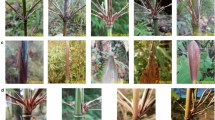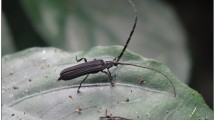Abstract
In the evolutionary process of an animal lineage, interactions in secondary contacts of differentiated populations and introgressive hybridization may play an important role. In the Japanese islands, the carabid subgenus Ohomopterus (genus Carabus) exhibits a marked differentiation in body size and genital morphology. Although geographical differentiation is apparent, two or three species usually coexist at many localities. Their reproductive isolation relies on body size differences, chemical cues for mate recognition, and a species-specific genital lock-and-key system. However, these isolation mechanisms are not always effective enough to prevent interspecific hybridization. An initial assessment of the species-level phylogeny with mitochondrial gene sequences revealed that the gene genealogy is highly inconsistent with the morphology-based taxonomy. A comparison of mitochondrial and nuclear gene genealogies showed that these are strongly incongruent with each other, while the nuclear gene genealogy is more consistent with traditional taxonomy, indicating the repeated occurrence of introgression of mitochondria across species. Here, two different cases of mitochondrial introgression among Ohomopterus species are described in detail, one for parapatric species and the other for sympatric species. First, mitochondrial haplotypes and sequences were studied in Carabus insulicola and three taxa parapatric with C. insulicola, at least two of which hybridize with C. insulicola naturally. Among the four species studied, directional introgressions of mitochondria across boundary zones were detected. Second, in the Mt. Kongo area in central Honshu, which harbors five species, introgression of mitochondria among four out of the five species was detected, despite the apparent absence of on-going natural hybridization. These inferred cases of mitochondrial introgression indicate that species interactions through hybridization could have played an important role at various stages in the evolution of Ohomopterus.
Similar content being viewed by others
Author information
Authors and Affiliations
Additional information
Received: April 12, 2002 / Accepted: October 17, 2002
Acknowledgments I am grateful to Alfried P. Vogler for a long-lasting collaboration in the molecular phylogenetic study of Ohomopterus. R. Ishikawa, K. Kubota, M. Ujiie, Y. Takami, and F. Kusumoto have also collaborated at various stages of this study. Thanks are also due to K. Miyashita, T. Funakoshi, H. Fujimoto, T. Dejima, Y. Nagahata, T. Miyagawa, K. Yodoe, H. Kadowaki, S. Nakamine, Y. Oka, H. Tanaka, T. Tanabe, K. Kusakari, and T. Okumura for their care of specimens. Supported by grants-in-aid from the Japan Society for the Promotion of Science (Nos. 09640748, 11304056).
Rights and permissions
About this article
Cite this article
Sota, T. Radiation and reticulation: extensive introgressive hybridization in the carabid beetles Ohomopterus inferred from mitochondrial gene genealogy. Popul Ecol 44, 0145–0156 (2002). https://doi.org/10.1007/s101440200018
Issue Date:
DOI: https://doi.org/10.1007/s101440200018




